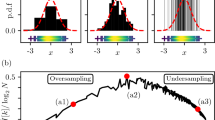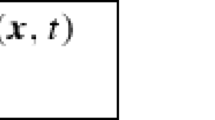Abstract
We introduce a novel notion of scale for signals which we illustrate for shape. It is based on the notion of entropy and a view of shocks as “black holes of information”. We propose that to properly place features in a hierarchy, we need both linear, global, and instantaneously propagated smoothing (e.g. Gaussian smoothing), as well as non-linear, local smoothing (e.g., certain morphological operators) that propagate information with finite speed. Both of these types of processes are brought together in the entropy scale space. The scheme is illustrated for shape, is intuitive and robust, and applicable in other areas of vision.5
Access this chapter
Tax calculation will be finalised at checkout
Purchases are for personal use only
Preview
Unable to display preview. Download preview PDF.
Similar content being viewed by others
References
J. Babaud, A. P. Witkin, M. Baudin, and R. O. Duda. Uniqueness of the gaussian kernel for scale-space filtering. PAMI, 8(1):26–33, January 1986.
F. W. Campbell and J. G. Robson. Applications of fourier analysis to the visibility of gratings. J. Physiol. (London), 197:551–556, 1968.
M.-H. Chen and P.-F. Yan. A multiscale approach based on morphological filtering. PAMI, 11(7):694–700, July 1989.
P. Garabedian. Partial Differential Equations. John Wiley and Sons, 1964.
E. Hopf. The partial differential equation u t + uu x = eu x x. Comm. Pure Appl. Math., 3:201–230, 1950.
R. Hummel, B. B. Kimia, and S. W. Zucker. Deblurring gaussian blur. Computer Vision, Graphics, and Image Processing, 38:66–80, 1987.
B. B. Kimia. Conservation laws and a theory of shape. Ph.D. dissertation, McGill Centre for Intelligent Machines, McGill University, Montreal, Canada, 1990.
B. B. Kimia, A. Tannenbaum, and S. W. Zucker. On the evolution of curves via a function of curvature, I: The classical case. JMAA, To appear, 1991.
J. J. Koenderink. The structure of images. Biol. Cybernetics, 50:363–370, 1984.
J. J. Koenderink and A. J. van Dooran. Visual detection of spatial contrast: Influence of location in the visual field, target extent and illuminance level. Biological Cybernetics, 30:157–167, 1978.
J. J. Koenderink and A. J. van Doom. Dynamic shape. Biol. Cyber., 53:383–396, 1986.
P. D. Lax. Shock Waves and Entropy, pages 603–634. Academic Press, New York, 1971.
P. D. Lax. Hyperbolic Systems of Conservation Laws and the Mathematical Theory of Shock Waves. SIAM Regional Conference series in Applied Mathematics, Philadelphia, 1973.
P. D. Lax. Shock waves, increase of entropy and loss of information. Technical Report DOE/ER/03077-240, Courant Mathematics and Computing Library-R&D Report, 1984.
F. Leymarie and M. D. Levine. Shape features using curvature morphology. In Proceedings of the SPIE “Intelligent Robots and Computer Vision VIII: Algorithms and Techniques” Conference, volume 1192, part 2, pages 536-547, Philadelphia, Penn., USA, November 1989.
P. Maragos. Pattern spectrum and multiscale shape representation. PAMI, 11(7):701–716, July 1989.
D. Marr and E. Hildreth. Theory of edge detection. Technical Report MIT AI Memo 518, MIT AI Lab, 1979.
F. Mokhtarian and A. Mackworth. Scale-based description of planar curves and two-dimensional shapes. PAMI, 8:34–43, 1986.
O. Oleinik. Discontinuous solutions of nonlinear differential equations. Amer. Math. Soc. Transl. Ser. 2, 26:95–172, 1957.
P. Perona and J. Malik. Scale-space and edge detection using anistroopic diffusion. PAMI, 12(7):629–639, July 1990.
W. Richards, B. Benjamin, and D. Whittington. Encoding contour shape by curvature extrema. JOSA A, 3(9):1483–1489, 1986.
A. Rosenfeld and M. Thurston. Edge and curve detection for visual scene analysis. IEEE Trans. Comput., C-20:562–569, 1971.
J. Smoller. Shock Waves and Reaction-Diffusion Equations. Springer-Verlag, New York, 1983.
D. Widder. The Heat Equation. Academic Press, 1975.
H. R. Wilson and J. R. Bergen. A four mechanism model for threshold spatial vision. Vision Research, 19(1):19–32, 1979.
A. P. Witkin. Scale-space filtering. In Proceedings of the 8 th International Joint Conference on Artificial Intelligence, pages 1019-1022, Karlsruhe, West Germany, Aug. 1983.
A. L. Yuille and T. A. Poggio. Scaling theorems for zero crossings. PAMI, 8(1):15–25, January 1986.
S. W. Zucker and R. Hummel. Receptive fields and the representation of visual information. Human Neurobiology, 5:121–128, 1986.
Author information
Authors and Affiliations
Editor information
Editors and Affiliations
Rights and permissions
Copyright information
© 1992 Springer Science+Business Media New York
About this chapter
Cite this chapter
Kimia, B.B., Tannenbaum, A., Zucker, S.W. (1992). Entropy Scale-Space. In: Arcelli, C., Cordella, L.P., di Baja, G.S. (eds) Visual Form. Springer, Boston, MA. https://doi.org/10.1007/978-1-4899-0715-8_33
Download citation
DOI: https://doi.org/10.1007/978-1-4899-0715-8_33
Publisher Name: Springer, Boston, MA
Print ISBN: 978-1-4899-0717-2
Online ISBN: 978-1-4899-0715-8
eBook Packages: Springer Book Archive




